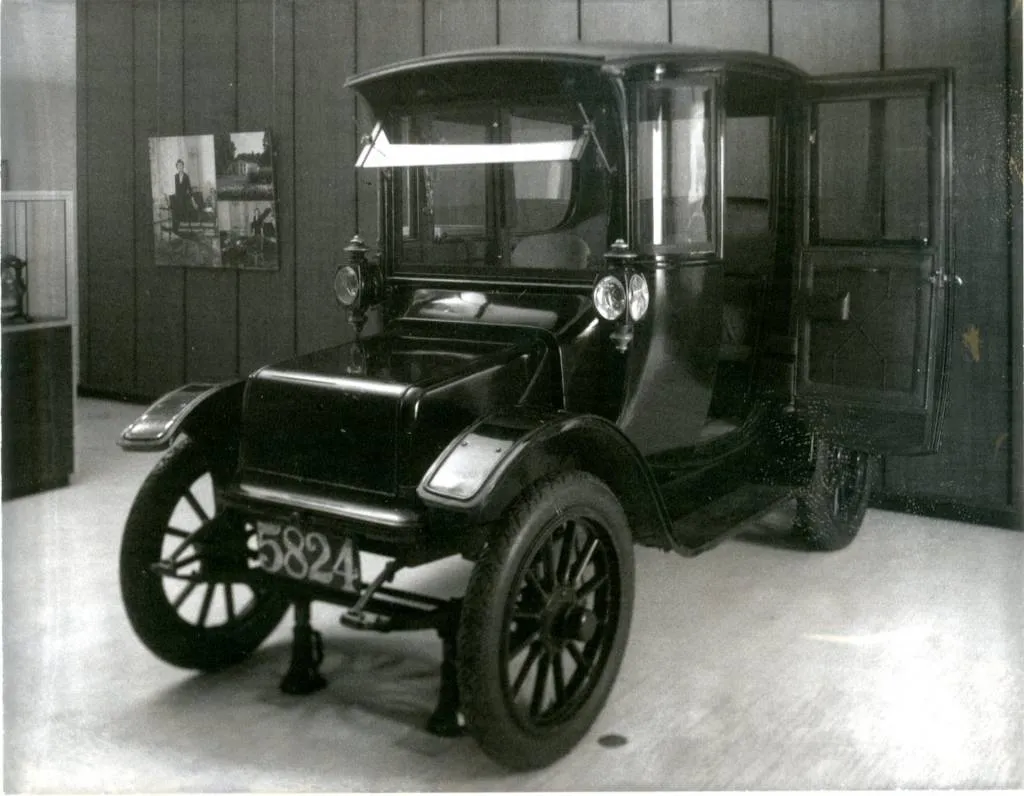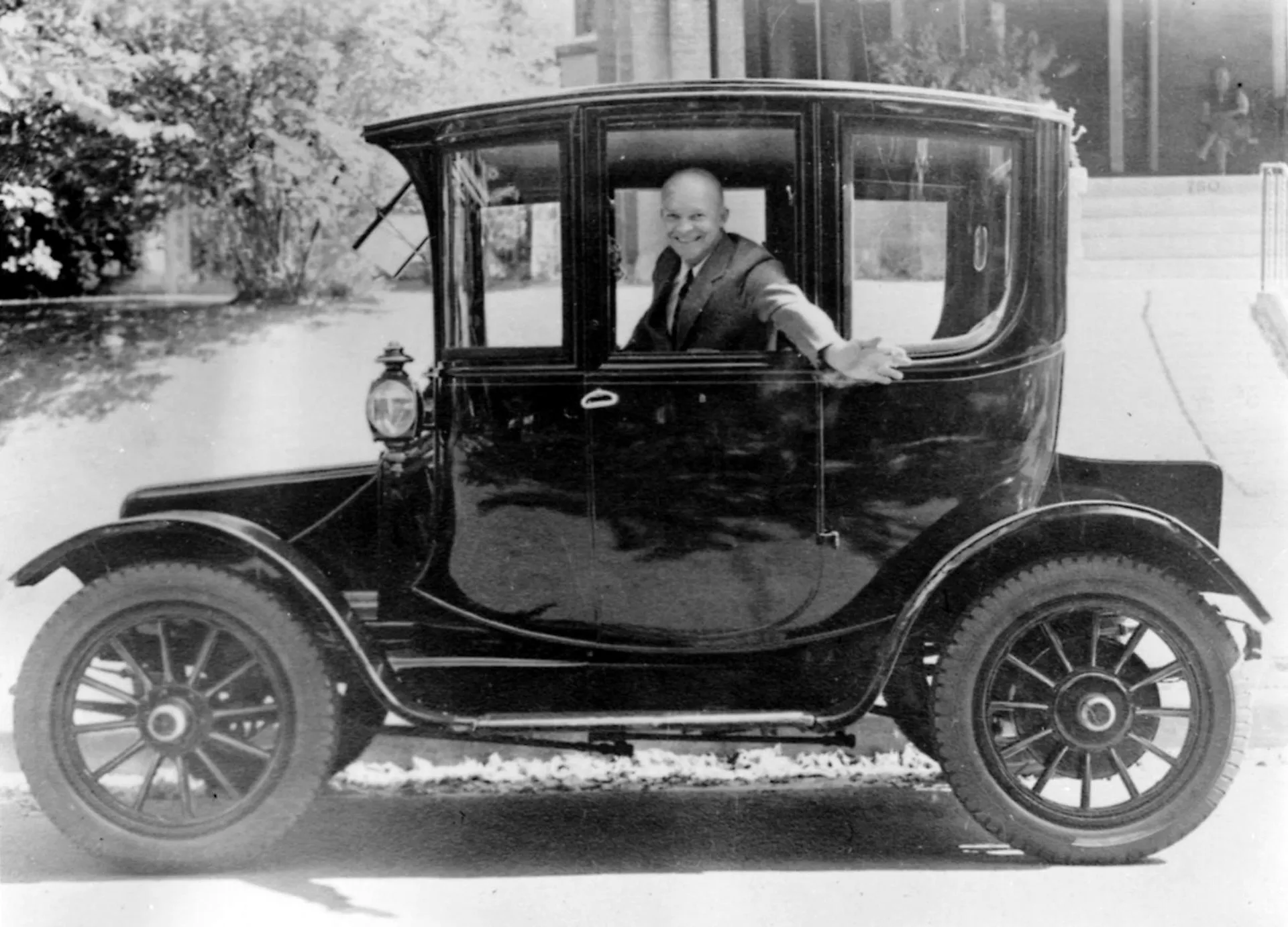At least a couple of presidents have been drivers of electric cars, but they’re not all in the recent past.
Our 34th President, Dwight David “Ike” Eisenhower, may have been one of the first. Long before Ike became perhaps the 20th century’s most famous general, Eisenhower drove around in an early electric car that belonged to his in-laws.
John Sheldon and Elvira Doud, Eisenhower’s father- and mother-in-law, owned the car—a 1914 Rauch & Lang electric car. Ike met their daughter Mamie in 1915 and asked her to marry him on Valentine’s Day the next year. The two courted, then married on July 1, 1916.
The Douds, a well-off couple who raised Mamie in Colorado, bought the car for $4,300 in 1914. That’s the equivalent of more than $135,000 today—far more than, say, a 2024 Mercedes-Benz EQS 580 sedan.
1914 Rauch & Lang electric car and President Dwight Eisenhower
The newly minted Eisenhowers drove the car on occasion, but bought their own used black Pullman roadster before they moved on to Washington, D.C. The automaker, which went out of business in 1917, barely outlived Ike and Mamie’s car, which often broke down on the military couple.
The Eisenhowers would drive gas-powered cars for the next few decades. Mamie drove everywhere as a newlywed in D.C., down bustling lanes where streetcars shared the lanes with Model Ts and the like. “When I would sometimes take Ike to the office in the morning,” she’d recall in an oral history taken in the year of her death, “you’d run into what we called then a great traffic problem, which is nothing in comparison to today.”
The succession of cars they owned leaned heavily toward Chryslers, but only after they shipped a Model T to Panama for a tour of duty in 1922. There was a 1948 Chrysler Crown Imperial, a 1950 model, then a 1952 model. Then, while Eisenhower served as President and Mamie as First Lady—from January 1953 to January 1961—the couple drove White House Motor Pool vehicles. Most of those vehicles were Chryslers, though the President drove Cadillacs and was driven in a 1950 “Bubbletop” Lincoln in many parades.
During his two terms in the White House, Eisenhower’s grandchildren also drove an electric car—a miniature one which they piloted down the hallways on the White House’s first floor after tour groups were gone for the day.
When they retired, they purchased two Chryslers from the White House fleet, to go with the various farm vehicles they used on their farm near Gettysburg, Pennsylvania.

1914 Rauch-Lang electric car
Eisenhower’s “death knell” for short-range EVs?
Eisenhower’s administrations preceded the modern electric car by decades, but his presidency had long-trailing effects on today’s EV market. In 1954, after proposing the interstate highway system in his State of the Union address, he advocated for a sustained gas tax to be used to build highways. In 1956 Eisenhower signed the Federal-Aid Highway Act into effect. In postwar America, “big government” had become a catalyst for a new American era of prosperity, and Eisenhower won over lawmakers with a plan to spend the princely sum of $50 billion to kickstart the construction of a much larger network of highways across the U.S.
Eisenhower christened the modern Interstate highway system. Already a half-century or more in the making—as rural dirt roads became modern state roads, then highways—Eisenhower’s massive public works project nevertheless may have rung the death knell for short-range EVs. With ribbons of asphalt promising to take Americans hundreds of miles away from home or back to it, and as streetcar systems were dismantled, gas stations mushroomed and likely erased the potential for infrastructure conceived around shorter travel distances.
Eisenhower died in 1969, long before his vice president, Richard Nixon, signed legislation to found the Environmental Protection Agency (EPA). Mamie died in 1972. It would take until the presidency of George W. Bush before electric vehicles became a better-funded national priority and at the same time, a political hot button.
Like so much of history, Ike’s legacy toward efficient transportation is complicated. At least in his day, any President could be adamantly pro-American and an EV driver.
Photos courtesy the Eisenhower Presidential Library.
Read the full article here




